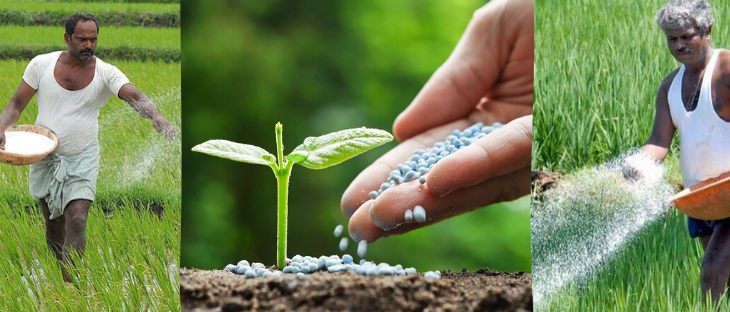पौधों की वृद्धि में पोषक तत्वों की अहमियत | Importance of nutrients in plant growth

सयाजी सीड्स की कृषि साक्षरता सिरीज़ के पांचवें एपिसोड में आपका स्वागत है। इस कार्यक्रम के जरिए हमारे कृषि वैज्ञानिक आपसे खेती से जुड़ी वो सारी बातें शेयर करेंगे, जिनसे कृषि उत्पादन पर फर्क पड़ता है।
किसान भाइयों, आज के एपिसोड में हम आपको बताएँगे पौधों की वृद्धि में पोषक तत्वों की अहमियत, वानस्पतिक अवस्था के दौरान खास पोषक तत्व की आवश्यकता और उर्वरक का इस्तेमाल। साथ-साथ, हम ये भी देखेंगे कि विश्व के उन्नत देशों ने मिट्टी और फसल में पोषक तत्वों की कमी का पता लगाने के लिए कौन सी नई तकनीकें ईजाद की हैं।
मित्रों, पौधों की वृद्धि में पोषक तत्वों का एक बड़ा योगदान रहता है। इसमें नाइट्रोजन, फास्फोरस, पोटैशियम, कैल्शीयम, मैग्नीशियम, और गंधक आदि तत्व काफी अहम माने जाते हैं। ये खास उर्वरक कुछ खास पोषक तत्वों की कमी को पूरा करते हैं। इन उर्वरकों को मिट्टी में डालने से फ़सलें अच्छी उगती हैं। खेती में आपको कितने उर्वरकों की जरूरत है ये सब मिट्टी की प्रकृति, मौसम, फसल की किस्म, उर्वरक की किस्म और उनकी कीमतों पर निर्भर करता है।
नाइट्रोजन एक प्रमुख घटक
पौधों की वानस्पतिक विकास की अवस्था में नाइट्रोजन एक प्रमुख घटक होता है। आमतौर पर पौधे इसे मिट्टी और वायुमंडल से ग्रहण करते हैं। नाइट्रोजन से पौधों की पत्तियों और टहनियों को ताकत मिलती है। पत्तियों में पक्की रंगत आती है।
आमतौर पर मिट्टी में नाइट्रोजन की मात्रा 0.1 से लेकर 0.25 तक रहती है। रेतीली भूमि में नाइट्रोजन की मात्रा तो इससे भी कम होती है। लेकिन, अगर आपने ज़मीन में गोबर की खाद डाली है तो नाइट्रोजन की मात्रा 0.25 से अधिक हो सकती है।
इसलिए, अगर आपकी मिट्टी में नाइट्रोजन की कमी हो तो अमोनियम सल्फ़ेट, अमोनियम नाइट्रेट, और यूरिया वगैरह को कृषि वैज्ञानिकों के निर्देशानुसार डालें।
उर्वरकों को डालते समय ध्यान रखने योग्य बातें
दर्शक मित्रों – आपको एक बात ध्यान में रखना है कि मिट्टी में पूरे का पूरा नाइट्रोजन एक बार में सक्रिय नहीं होता। पौधे इसे धीरे-धीरे करके लेते हैं। इसलिए…
• उर्वरकों को पौधों की जड़ों के पास डालें। इससे वे आसानी से इसे ले सकेंगे।
• उर्वरकों का छिड़काव करने के बाद, उनके ऊपर हल्की सिंचाई करें।
• पौधों के अच्छे स्वास्थ्य के लिए मिट्टी का पीएच लेवल (5.5-6.3) बनाए रखें।
• जब पौधे में फूल निकलना शुरु हो जाए तो उसे नाइट्रोजन देना बंद कर दें। क्योंकि, पौधे कई तत्वों को हवा से भी लेते रहते हैं।
ये बात ध्यान रहे – ज्यादा नाइट्रोजन वाले खेत में पौधे के गिरने या फंगस के आक्रमण होने का खतरा बढ़ जाता है। गेहूं और धान के पौधों में ऐसा अक्सर देखने को मिलता है।
किसान मित्रों – खेतों में उर्वरकों को डालने के पीछे का मकसद पैदावार को बढ़ाना होता है। पर, अगर आपने समझदारी से काम नहीं लिया तो आपको उल्टे नुकसान भी उठाना पड़ सकता है। इसलिए, पौधे की वानस्पतिक अवस्था में उर्वरकों का छिड़काव करते समय इस बात की पहले पड़ताल कर लें कि क्या आपके पौधों को वाकई में इनकी जरूरत है। मृदा परीक्षण करवाने से मिट्टी के पोषक तत्वों की कमी या अधिकता का पता चलता है। सरकार द्वारा निर्धारित मिट्टी परीक्षण केंद्रों से आप सस्ती कीमत पर अपने मिट्टी के नमूने की जांच करवा सकते हैं।
आज पौधों में पोषण के महत्व को हल्के में नहीं लिया जा रहा है और अमेरिका,कनाडा,अर्जेंटीना, और ऑस्ट्रेलिया जैसे देशों ने पौधों के पोषण के आकलन के लिए अलग-अलग मिट्टी और फसल सेंसर तैयार किये हैं। ये स्मार्ट सेंसर आपको फसल की ज़रूरतों के मुताबिक मिट्टी के पीएच लेवल, नाइट्रोजन जैसे पोषक तत्वों और अन्य कार्बनिक पदार्थों की समय-समय पर सही-सही जानकारियाँ आपको प्रदान करेंगे, जिसकी मदद से आप सही मौके पर कृषि उपायों को लागू करके आप अपनी फसल से एक अच्छी पैदावार हासिल करेंगे।
अभी, कृषि के इन आधुनिक तरीकों को भारत में आने में कुछ समय लगेगा। इसकी वजह खेती योग्य भूमि का छोटा होना और बड़े पैमाने पर इन तकनीकों को सस्ते दामों तक किसानों तक पहुंचाने में होने वाली दिक्कतें हैं।
फिलहाल, भारत में मृदा परीक्षण सुविधा ही उपलब्ध है। जिसके उपयोग में आपको जरा भी देरी नहीं करनी चाहिए और तुरंत इसका अधिक से अधिक फायदा उठाना चाहिए।
किसान भाइयों, ये वीडियो आपको कैसा लगा। कमेंट बॉक्स के जरिये हमें ज़रूर बताइये कि आपने अपनी फ़सलों में पोषक तत्वों की कमी को कैसे पूरा किया।
और हां… कृषि से जुड़ी सलाह पाने के लिए सयाजी सीड्स की कृषि साक्षरता सिरीज़ को सब्सक्राइब करना ना भूलें। अगर आपके मन में कृषि संबंधी कोई सवाल है तो बेझिझक हमसे पूछिये। हमारे कृषि वैज्ञानिक आपके सवालों का जवाब लेकर जल्द हाज़िर होंगे।
आज ही हमारे YOUTUBE चैनल को सब्सक्राइब करे >> 📲📲📲
किसान बंधुओ के लिए ख़ास कारिक्रम – कृषि साक्षरता सीरीज़ को भी देखना ना भूले >> 📲📲📲
Welcome to the fifth episode of Sayaji Seeds’ Agricultural Literacy Series. Through this program, our agricultural scientists will share with you all the things related to farming, which make a difference on agricultural production.
Farmer brothers, in today’s episode we will tell you the importance of nutrients in plant growth, the requirement of certain nutrients during the vegetative stage and the use of fertilizer. Simultaneously, we will also see what new technologies have been developed by the advanced countries of the world to detect the deficiency of nutrients in soil and crop.
Friends, nutrients contribute to the growth of plants. Nitrogen, phosphorus, potassium, calcium, magnesium, and sulfur etc. are considered very important in this. These special fertilizers cater to certain nutrient deficiencies. Crops grow well by putting these fertilizers in the soil. How many fertilizers you need in farming all depends on the nature of the soil, the season, the variety of crop, the variety of fertilizer and their prices.
Nitrogen is a major component
Nitrogen is a major component in the vegetative growth stage of plants. Plants usually receive it from soil and atmosphere. Nitrogen provides strength to the leaves and twigs of plants. The leaves have a solid color.
Generally nitrogen content in soil varies from 0.1 to 0.25. The amount of nitrogen in sandy land is even less. However, if you have added manure of cow dung to the ground then the nitrogen content can be more than 0.25.
Therefore, if your soil is deficient in nitrogen, then add ammonium sulfate, ammonium nitrate, and urea, etc. as instructed by agricultural scientists.
Things to keep in mind while adding fertilizers
Audience friends – one thing you have to keep in mind is that the entire nitrogen in the soil is not activated at once. Plants do this slowly. Hence…
• Apply fertilizers near the roots of the plants. This will enable them to take it easily.
• After spraying fertilizers, apply light irrigation on them.
• Maintain soil pH level (5.5-6.3) for good health of plants.
• When the plant starts to flower, stop giving nitrogen to it. Because, plants also take many elements from the air.
Keep in mind – In a field with high nitrogen, the risk of plant fall or fungus attack increases. This is often seen in wheat and paddy plants.
Farmer friends – The motive behind putting fertilizers in the fields is to increase the yield. However, if you do not act wisely, then you may also have to suffer the opposite.
Therefore, while spraying fertilizers in the vegetative stage of the plant, first check if your plants really need them. A soil test reveals a deficiency or excess of soil nutrients. You can get your soil samples tested at a cheaper price from government-determined soil testing centers.
Today, the importance of nutrition in plants is not being taken lightly, and countries such as the US, Canada, Argentina, and Australia have designed different soil and crop sensors to assess plant nutrition. These smart sensors will give you accurate information of soil pH level, nutrients like nitrogen and other organic matter from time to time according to crop requirements, which will help you to apply agricultural measures at the right time.
Right now, these modern methods of agriculture will take some time to come to India. The reason for this is the small size of the cultivable land and the problems caused in delivering these technologies to the farmers on a large scale.
At present, only soil testing facility is available in India. Which you should not delay at all and should get the most out of it immediately.
Farmer brothers, how did you like this video. Tell us through the comment box how you have overcome the nutritional deficiency in your crops.
And yes … do not forget to subscribe to the agricultural literacy series of Sayaji Seeds for advice related to agriculture. If you have any agriculture related question, feel free to ask us. Our agricultural scientists will be quick to answer your questions.
Don’t forget to subscribe our YOUTUBE Channel >> 📲📲📲
And don’t forget to watch our special Agricultural Education Series >> 📲📲📲

